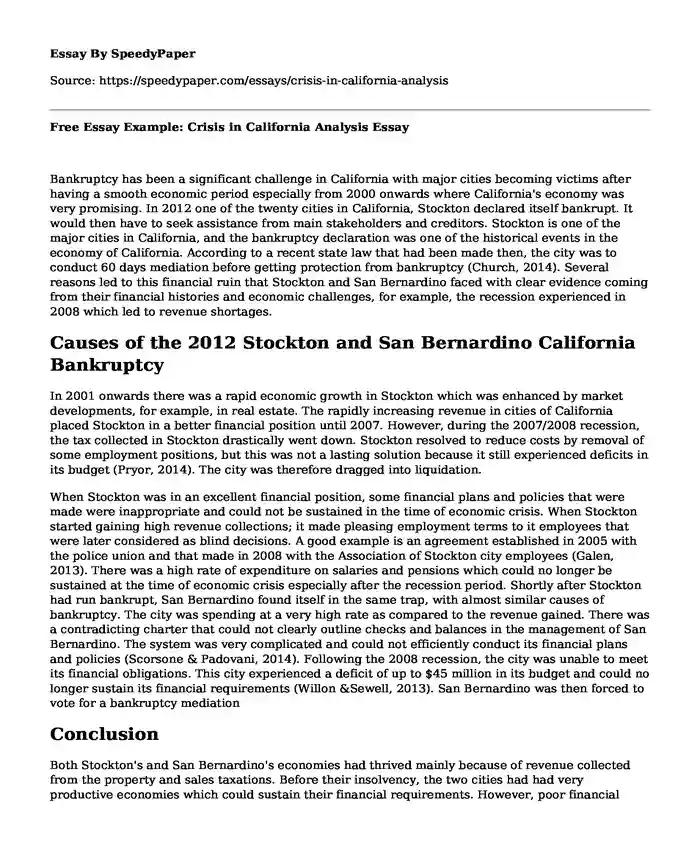Bankruptcy has been a significant challenge in California with major cities becoming victims after having a smooth economic period especially from 2000 onwards where California's economy was very promising. In 2012 one of the twenty cities in California, Stockton declared itself bankrupt. It would then have to seek assistance from main stakeholders and creditors. Stockton is one of the major cities in California, and the bankruptcy declaration was one of the historical events in the economy of California. According to a recent state law that had been made then, the city was to conduct 60 days mediation before getting protection from bankruptcy (Church, 2014). Several reasons led to this financial ruin that Stockton and San Bernardino faced with clear evidence coming from their financial histories and economic challenges, for example, the recession experienced in 2008 which led to revenue shortages.
Causes of the 2012 Stockton and San Bernardino California Bankruptcy
In 2001 onwards there was a rapid economic growth in Stockton which was enhanced by market developments, for example, in real estate. The rapidly increasing revenue in cities of California placed Stockton in a better financial position until 2007. However, during the 2007/2008 recession, the tax collected in Stockton drastically went down. Stockton resolved to reduce costs by removal of some employment positions, but this was not a lasting solution because it still experienced deficits in its budget (Pryor, 2014). The city was therefore dragged into liquidation.
When Stockton was in an excellent financial position, some financial plans and policies that were made were inappropriate and could not be sustained in the time of economic crisis. When Stockton started gaining high revenue collections; it made pleasing employment terms to it employees that were later considered as blind decisions. A good example is an agreement established in 2005 with the police union and that made in 2008 with the Association of Stockton city employees (Galen, 2013). There was a high rate of expenditure on salaries and pensions which could no longer be sustained at the time of economic crisis especially after the recession period. Shortly after Stockton had run bankrupt, San Bernardino found itself in the same trap, with almost similar causes of bankruptcy. The city was spending at a very high rate as compared to the revenue gained. There was a contradicting charter that could not clearly outline checks and balances in the management of San Bernardino. The system was very complicated and could not efficiently conduct its financial plans and policies (Scorsone & Padovani, 2014). Following the 2008 recession, the city was unable to meet its financial obligations. This city experienced a deficit of up to $45 million in its budget and could no longer sustain its financial requirements (Willon &Sewell, 2013). San Bernardino was then forced to vote for a bankruptcy mediation
Conclusion
Both Stockton's and San Bernardino's economies had thrived mainly because of revenue collected from the property and sales taxations. Before their insolvency, the two cities had had very productive economies which could sustain their financial requirements. However, poor financial planning and blindly making inappropriate policies cost these two cities leading them into financial crises. For instance, high costs of pension payments and increased salaries to city workers could no longer be sustained especially after the 2007/2008 which left these cities with very little revenue that could no longer support the budget required to maintain Stockton and San Bernardino. To avoid a replica of what happened in cities such as Stockton and San Bernardino should embrace proper planning. Although every local authority has its way of management, those making policies at the local level should ensure that there is a balance between the revenue collected and the amount that is spent. This action would avoid any financial shortcomings in future
References
Pryor, C. S. (2014). Municipal Bankruptcy: When doing less is Doing Best. Am. Bankr. LJ, 88, 85.
Church, S. (2014). Calpers No Better Than Bondholders in Stockton Bankruptcy.
Galen, M. (2013). Chapter 9 bankruptcy in California: the efficacy of mandating alternative dispute resolution in municipal bankruptcy filings. Cardozo J. Conflict Resol., 15, 547.
Scorsone, E., & Padovani, E. (2014). Through the complexity of bankruptcy in local governments. Public Finance and Management, 14(1), 1-4.
Willon, P., & Sewell, A. (2012). Plenty of blame on the long road to San Bernardino bankruptcy. Los Angeles Times.
Cite this page
Free Essay Example: Crisis in California Analysis. (2022, Jun 01). Retrieved from https://speedypaper.com/essays/crisis-in-california-analysis
Request Removal
If you are the original author of this essay and no longer wish to have it published on the SpeedyPaper website, please click below to request its removal:
- Free Essay with an Annotated Bibliography on Systems Theory
- Internet In Our Life Essay Samples
- Arts, Crafts and Cultural Manifestations - Free Essay Example
- Essay Sample: Higher Education Should Be Free for Students
- Crisis Management and Disaster Preparedness Essay Sample
- Education Essay Example on University Entrepreneurship
- Essay Example Answering the Questions Related to Vegetarianism
Popular categories





